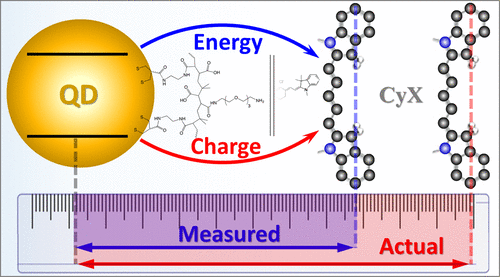Our official English website, www.x-mol.net, welcomes your feedback! (Note: you will need to create a separate account there.)
Competition of Charge and Energy Transfer Processes in Donor–Acceptor Fluorescence Pairs: Calibrating the Spectroscopic Ruler
ACS Nano ( IF 17.1 ) Pub Date : 2018-06-08 00:00:00 , DOI: 10.1021/acsnano.8b01451 Pavel Moroz , Zhicheng Jin 1 , Yuya Sugiyama 1 , D’Andree Lara 2 , Natalia Razgoniaeva , Mingrui Yang , Natalia Kholmicheva , Dmitriy Khon 2 , Hedi Mattoussi 1 , Mikhail Zamkov
ACS Nano ( IF 17.1 ) Pub Date : 2018-06-08 00:00:00 , DOI: 10.1021/acsnano.8b01451 Pavel Moroz , Zhicheng Jin 1 , Yuya Sugiyama 1 , D’Andree Lara 2 , Natalia Razgoniaeva , Mingrui Yang , Natalia Kholmicheva , Dmitriy Khon 2 , Hedi Mattoussi 1 , Mikhail Zamkov
Affiliation

|
Sensing strategies utilizing Förster resonance energy transfer (FRET) are widely used for probing biological phenomena. FRET sensitivity to the donor–acceptor distance makes it ideal for measuring the concentration of a known analyte or determining the spatial separation between fluorescent labels in a macromolecular assembly. The difficulty lies in extracting the FRET efficiency from the acceptor-induced quenching of the donor emission, which may contain a significant non-FRET contribution. Here, we demonstrate a general spectroscopic approach for differentiating between charge transfer and energy transfer (ET) processes in donor–acceptor assemblies and apply the developed method for unravelling the FRET/non-FRET contributions in cyanine dye–semiconductor quantum dot (QD) constructs. The present method relies on correlating the amplitude of the acceptor emission to specific changes in the donor excitation profile in order to extract ET-only transfer efficiencies. Quenching of the donor emission is then utilized to determine the non-ET component, tentatively attributed to the charge transfer. We observe that the latter accounts for 50–99% of donor emission quenching in QD-Cy5 and QD-Cy7 systems, stressing the importance of determining the non-FRET efficiency in a spectroscopic ruler and other FRET-based sensing applications.
中文翻译:

供体-受体荧光对中电荷和能量转移过程的竞争:校准光谱尺
利用福斯特共振能量转移(FRET)的传感策略已广泛用于探测生物现象。FRET对供体-受体距离的灵敏度使其非常适合测量已知分析物的浓度或确定大分子装配体中荧光标记之间的空间间隔。困难在于从受主诱导的供体发射猝灭中提取FRET效率,这可能包含显着的非FRET贡献。在这里,我们展示了一种区分供体-受体组件中电荷转移和能量转移(ET)过程的通用光谱方法,并应用了开发的方法来揭示花菁染料-半导体量子点(QD)结构中的FRET /非FRET贡献。本方法依赖于使受体发射的振幅与供体激发分布中的特定变化相关,以便提取仅ET的转移效率。然后利用给体发射的猝灭来确定暂时归因于电荷转移的非ET成分。我们观察到,后者占QD-Cy5和QD-Cy7系统中供体发射猝灭的50–99%,强调了在光谱尺和其他基于FRET的传感应用中确定非FRET效率的重要性。
更新日期:2018-06-08
中文翻译:

供体-受体荧光对中电荷和能量转移过程的竞争:校准光谱尺
利用福斯特共振能量转移(FRET)的传感策略已广泛用于探测生物现象。FRET对供体-受体距离的灵敏度使其非常适合测量已知分析物的浓度或确定大分子装配体中荧光标记之间的空间间隔。困难在于从受主诱导的供体发射猝灭中提取FRET效率,这可能包含显着的非FRET贡献。在这里,我们展示了一种区分供体-受体组件中电荷转移和能量转移(ET)过程的通用光谱方法,并应用了开发的方法来揭示花菁染料-半导体量子点(QD)结构中的FRET /非FRET贡献。本方法依赖于使受体发射的振幅与供体激发分布中的特定变化相关,以便提取仅ET的转移效率。然后利用给体发射的猝灭来确定暂时归因于电荷转移的非ET成分。我们观察到,后者占QD-Cy5和QD-Cy7系统中供体发射猝灭的50–99%,强调了在光谱尺和其他基于FRET的传感应用中确定非FRET效率的重要性。



























 京公网安备 11010802027423号
京公网安备 11010802027423号